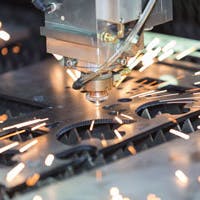Selecting CNC Machines for Sheet Metal Fabrication
When it comes to sheet metal fabrication, there are a number of CNC machines that can help improve overall efficiency and reduce the cost per part. This article will help demystify the process of selecting CNC machines for sheet metal fabrication and will shine some light on their advantages and disadvantages.

When it comes to sheet metal fabrication, there are a number of CNC machines that can help improve overall efficiency and reduce the cost per part. This article will help demystify the process of selecting CNC machines for sheet metal fabrication and will shine some light on their advantages and disadvantages.
CNC Cutting Machines
Sheet metal operations typically consist of cutting, bending, rolling, and welding parts together to form inexpensive, lightweight parts.
A CNC cutting machine can have a significant impact on manufacturing operations. They can cut complex shapes from sheet stock, including holes and bend reliefs. Some machines can even mark out bend lines to assist manual bending brake press operators in accurately bending the parts. The following are the major CNC cutting machine types:
CNC Laser Cutter
Laser cutters are the most commonly used machines for sheet metal as they can cut most materials, at a variety of thicknesses, depending on the laser power. Laser cutting machines are best for cutting thin materials of less than ¼ inch (6.35 mm) and produce the best quality cut at the highest speed for thin materials, making them ideal for sheet metal fabrication. Laser cutters are, however, more expensive than plasma cutters but cheaper than waterjet cutters.
CNC Plasma Cutter
A plasma cutter works by generating a beam of high-temperature plasma that cuts through the metal. An electric circuit is created through the plasma beam that then passes through the workpiece which is also attached to the circuit. This means that plasma cutters can only cut conductive materials. In general the higher the conductivity the better. Lower conductivity materials do not cut as easily as higher conductivity materials like copper. These machines are usually cheaper than laser cutters. They are best suited to medium-thickness materials that can range from 15 to 50 mm. Thinner materials tend to heat up too much causing excessive warping.
CNC Waterjet
A waterjet cutter works by blasting abrasive-laden water at extremely high pressures to cut through materials up to 10 inches (254 mm) thick. Unlike a plasma cutter, the waterjet is not limited to conductive materials. It has the unique advantage over all other cutting methods of adding no heat into the material. The waterjet’s major disadvantage is that it is expensive to operate. A second disadvantage is that when it comes to fine detail on thin materials, laser cutting machines come out ahead. One unique benefit of waterjet machines is that they can cut stacks of plates, thus dramatically increasing their productivity. Waterjet cutters are not as environmentally friendly as the other cutters mentioned as they require significant amounts of water and spray a mix of water and abrasives all over the place which is difficult to clean and recycle.
FREE CNC Machining Design Guide
CNC Forming Machines
After the parts have been cut, they need to be either bent or rolled into their final shapes. The machines typically used for this are bending brakes and plate rollers.
CNC Bending Brake
CNC bending brakes can significantly increase the speed with which parts are bent. There is no need to manually align the bend lines in the machine since it automatically moves the backstops to the required location. The operator just needs to push the plate against the backstops which have been precisely positioned and the machine will perform the bend. Operators are still required to place the part into the machine in the correct order.
CNC Roller
A CNC roller reduces the time taken to produce cylindrical or conical sheet metal parts by automating most of the rolling process. A CNC roller can produce cylindrical parts as well as non-cylindrical hollow parts. Some machines can virtually eliminate flat spots without having to re-roll the cylinder after welding.
A machine shop can benefit greatly from the wide range of sheet metal fabrication machines available. The cost of these machines demands a careful, step-by-step plan for adding one to your shop's capabilities. This can be done by determining which process is currently causing the biggest production bottleneck or on which machine can unlock new revenue streams, and focusing efforts on that one process. This stepwise approach is the most cost-effective way of selecting CNC machines for sheet metal processes.
